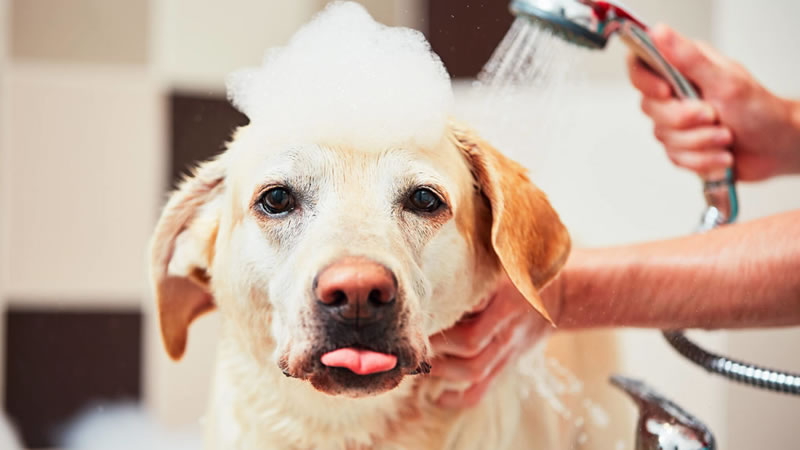Home grooming can save money and be a bonding experience between pet owner and dog. The right tools and techniques can also make dog grooming easier.
People decide to groom a dog at home for many reasons ranging from economic need to senior dog issues. Many pet owners can easily learn how to groom a dog at home with minimal investment in grooming supplies.
Affordable Dog Grooming Supplies:
Expensive equipment is not necessary to groom a dog at home. A pet owner only needs the following equipment to effectively groom her pet:
- A dog clipper for cutting fur – Clippers are the safest way to cut dog fur because they are designed to make it nearly impossible to accidentally cut the dog’s skin. Clippers are available at various prices, ranging from $20 to over $200. The price depends upon the brand and features. Andis and Oster are top brands and offer clippers labeled “professional” with multiple speeds, self-cleaning motors, quieter motors and heat control. Cheaper clippers tend to have only one speed, are louder and can get hot when they run too long.
- Clipper blades – The clipper blade selected will determine how short the clipper cuts the fur. Most blades designed for dog clippers are compatible with any brand model. Spend the money on the dog clipper and buy the blade that’s on sale. The #10 blade is the standard size for cutting fur extremely short and shaving fur. #4 is another standard size that cuts smaller amounts of fur, allowing a person to shape a style. If a pet owner can only have two blades, a #10 and a #4 can provide a nice cut for more fur types.
- Dog nail trimmers – Most veterinarians prefer manual scissor-type or guillotine dog nail trimmers for safe and precise toenail trimming. These manual nail trimmers are also cheaper than the pet nail sander devices. The electronic dog nail sanders are advertised as user-friendly and some even cauterize the nail if the quick is severed. If used properly, the devices are an option. However, never cut the dog’s nail too short, even if the device cauterizes the quick, because it will be painful to the dog.
- Blunt-tipped grooming scissors – Every household should have one pair of basic 7.5″ or 5.5″ blunt-tipped grooming scissors. Grooming scissors can be helpful for trimming extra long fur between footpads or shaping a dog’s leg hair. Be very careful whenever using scissors.
- Slicker dog brush – Dog slicker brushes help detangle fur and work out mats. This brush should be used before using a bristle brush.
- Bristle dog brush – Use bristle brushes after the fur is detangled to spread the dog’s natural oils (sebum) throughout the coat. This will soften the fur and add shine.
- Metal dog comb – Metal combs are the first line of defense against tangles. Comb the fur before using either a slicker brush or a bristle brush. Work out tough mats with the comb.
- Dog shampoo – Use a mild shampoo made for dogs. Never use human shampoo because dogs have a different skin pH than people and the product could cause skin irritation. Pick a mild shampoo with moisturizing properties.
- Dog conditioner or cream rinse (optional) – Dogs with tangle-prone coats or really dry fur and skin can benefit from a dog conditioner. Many dog conditioners are called cream rinse. There are also spray leave-in conditioners that can be used between shampoos to help with tangles and fur manageability.
- Blowdryer – Air dry the dog’s fur or use a regular blowdryer to speed up drying and style the coat.
Grooming a Dog’s Face and Tail:
These tips can help make grooming dog’s facial area easier:
- Be extra careful working around a dog’s face, especially if using grooming scissors. Grooming scissors can sometimes help shape the fur around the dog’s head and muzzle, especially in breeds like Schnauzers.
- Some dog’s need to have their eyelashes trimmed. There are special small blunt-tipped grooming scissors that make trimming eyelashes easier.
- Always shave the anal area with a #10 blade to keep the region clean. Check the anal glands to make sure they are not full.
Dealing with Dog Grooming Difficulties
Some pet owners choose to groom a dog at home because the dog hates getting groomed with a passion. When working with a dog who dislikes grooming, ease into the process by breaking up the grooming into multiple sessions. One session is for bathing. Another session is for brushing and combing. The actual fur cutting and nail trimming are also divided up. The sessions can be divided throughout one day or a number of days. Praise the dog during grooming for being still and reward him with a treat at the end of each session. Over time the dog will accept the grooming and it will be easier.


